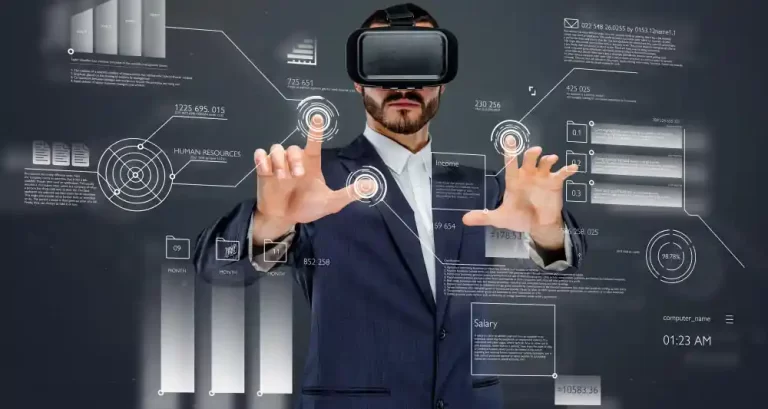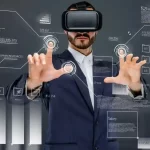What is Augmented Reality
Augmented Reality (AR) is an interactive technology that overlays digital information, images, and other virtual objects onto the real-world environment. It uses a device’s camera, sensors, and algorithms to identify and track real-world objects and superimpose virtual content on top of them.
AR can be experienced through a variety of devices, including smartphones, tablets, smart glasses, and head-mounted displays. It allows users to interact with the digital content in real-time and in a more natural and intuitive way, as if the virtual objects were part of the physical world.
AR has a wide range of applications, including gaming, education, retail, advertising, and manufacturing. For example, AR can be used to create immersive gaming experiences, provide real-time visual guidance in complex manufacturing processes, or enhance customer engagement in retail stores by allowing them to try out products virtually before making a purchase.
Augmented Reality (AR) is an interactive technology that combines the digital and physical world by overlaying virtual information, such as images, videos, or 3D models, on the real-world environment. AR uses devices such as smartphones, tablets, or smart glasses, to display the digital content, which is usually triggered by markers or other sensors in the physical world.
AR technology enhances the user’s perception of reality, allowing them to interact with the digital content as if it were a part of their immediate environment. AR can be used for a variety of applications, such as entertainment, education, training, marketing, and more. Some popular examples of AR applications include Pokemon Go, Snapchat filters, and IKEA’s AR furniture placement tool.
Examples of Augmented Reality
It has become increasingly popular in recent years and has a wide range of applications. Here are some examples of how AR is being used in different industries:
- Gaming: One of the most well-known examples of AR is the mobile game Pokémon Go, which overlays virtual creatures onto real-world environments.
- Education: AR is being used to enhance learning by allowing students to explore historical sites, dissect virtual organisms, and interact with 3D models.
- Retail: AR can be used to provide customers with an interactive shopping experience, allowing them to see how products would look in their homes before purchasing.
- Healthcare: AR is being used to assist with medical procedures and training by allowing doctors to see 3D images of organs and bones overlaid onto the patient’s body.
- Tourism: AR can be used to enhance the tourism experience by providing users with information about their surroundings as they explore new places.
- Real estate: AR can be used to provide potential buyers with a virtual tour of a property, allowing them to see how furniture would look in different rooms and get a better sense of the space.
- Manufacturing: AR is being used to assist with assembly and repair work by overlaying instructions and information onto the real world, making it easier for workers to complete tasks.
- Sports: AR is being used to provide fans with an enhanced viewing experience by overlaying real-time statistics and information onto live games.
Features of Augmented Reality
Augmented Reality (AR) is a technology that enhances the real world by overlaying digital information or graphics onto physical objects or environments. Here are some common features of Augmented Reality:
- Real-time interaction: AR technology allows users to interact with digital objects or information in real-time. Users can manipulate or control virtual objects through gestures, voice commands, or other inputs.
- Object recognition and tracking: AR applications use computer vision algorithms to recognize and track physical objects in the real world. This enables the overlay of digital information on specific objects or surfaces.
- Spatial mapping: AR systems create a digital map of the user’s environment, allowing virtual objects to be placed in specific locations and interact with physical objects.
- 3D modeling: AR technology can create 3D models of physical objects in real-time, allowing users to view and manipulate them from different angles.
- Location-based services: AR applications can provide location-based information, such as the nearest restaurant or store, by overlaying the information onto the user’s view of the real world.
- Multi-platform compatibility: AR technology can be integrated with various platforms and devices, including smartphones, tablets, and wearable devices.
- Immersive experiences: AR technology can create immersive experiences by overlaying digital information onto the user’s view of the real world, enhancing their perception and understanding of the environment.
Difference between Augmented Reality and Virtual Reality
Augmented Reality (AR) and Virtual Reality (VR) are two distinct technologies used to create immersive and interactive experiences for users. The primary difference between AR and VR is the way they integrate digital content with the real world.
Augmented Reality (AR) is a technology that overlays digital information, such as images, graphics, and sounds, onto the user’s view of the real world. AR can be experienced through a variety of devices, such as smartphones, tablets, and smart glasses. With AR, the user remains aware of their real-world surroundings while interacting with digital content that is superimposed on top of it. Examples of AR include Snapchat filters, Pokemon Go, and IKEA’s Place app.
Virtual Reality (VR) is a technology that creates a simulated, immersive environment that users can interact with. VR typically requires the use of a headset that covers the user’s eyes and ears, blocking out the real world and replacing it with a fully digital environment. VR can be used for a variety of applications, such as gaming, education, and training simulations. Examples of VR include video games like Beat Saber and Half-Life: Alyx, as well as educational applications like Google Expeditions.
Augmented Reality (AR) is a technology that superimposes computer-generated images or other digital content onto the real world, enhancing or “augmenting” what we see and experience. AR technology can be used to create interactive experiences, such as games or educational tools, that blend digital content with the real world. For example, AR could be used to create a virtual tour of a museum exhibit, with digital information overlaid onto the physical objects.
Virtual Reality (VR), on the other hand, is a technology that immerses the user in a completely digital environment, simulating a sense of presence in a virtual world. VR typically involves wearing a headset that blocks out the physical world and replaces it with a fully immersive digital environment. VR technology can be used to create simulations for training, gaming, or even therapy, allowing users to experience a different reality that is not limited by the physical constraints of the real world.
In summary, AR enhances the real world by adding digital elements to it, while VR creates a completely digital world that the user can interact with.
Types of Augmented Reality
There are several types of augmented reality (AR), including:
- Marker-based AR: This type of AR uses a camera and a visual marker to trigger the appearance of virtual content. The marker serves as a reference point, and when the camera recognizes it, the virtual content is overlaid on top of the marker.
- Marker less AR: Also known as location-based AR, this type of AR uses the device’s GPS, compass, and accelerometer to place virtual content in the real world. Examples include Pokemon Go and AR navigation apps.
- Projection-based AR: This type of AR projects virtual content onto real-world objects, creating the illusion that the objects are transformed or animated. This is often used in advertising and art installations.
- Superimposition-based AR: This type of AR replaces a real-world object with a virtual object, such as a virtual try-on for clothes or furniture.
- Outlining-based AR: This type of AR creates an outline of a real-world object and replaces it with a virtual version. This is often used in industrial design and architecture to visualize how a product or building will look in the real world.
- Face Recognition AR: This type of AR uses computer vision and facial recognition technology to overlay virtual content onto a user’s face, often used in AR filters on social media platforms.
- Hybrid AR: This type of AR combines two or more types of AR to create more complex and immersive experiences.
Advantages
Augmented Reality (AR) technology offers several advantages in a variety of applications. Here are some of the main advantages of AR:
- Enhanced user experience: AR adds a layer of digital information to the physical world, making the user experience more immersive and interactive.
- Improved visualization: AR can help users visualize complex concepts or data in a more intuitive way, making it easier to understand and analyze.
- Increased engagement: AR technology can be used to create engaging and interactive experiences that capture users’ attention and keep them engaged for longer periods of time.
- Cost-effective: AR can be implemented using relatively inexpensive hardware, such as smartphones and tablets, making it accessible to a wide range of users.
- Real-time feedback: AR can provide real-time feedback on tasks, such as assembly or repair, by overlaying digital information on the physical object, allowing users to make adjustments quickly and easily.
- Remote collaboration: AR can facilitate remote collaboration by allowing users to share their augmented reality views with others, making it easier to work together from different locations.
- Marketing and advertising: AR can be used in marketing and advertising to create engaging and interactive campaigns that capture users’ attention and increase brand awareness.
Overall, AR technology has the potential to revolutionize many different industries and applications, from education and healthcare to gaming and entertainment.
Disadvantages
- Limited field of view: Most augmented reality devices, such as smartphones or head-mounted displays, have a limited field of view. This means that users can only see augmented content within a small area, which can be frustrating and limit the usefulness of the technology.
- Battery life: Augmented reality requires a lot of processing power, which can quickly drain the battery of a device. This means that users may not be able to use augmented reality for extended periods of time without needing to recharge their device.
- Cost: Augmented reality devices can be expensive, especially high-end head-mounted displays. This can make it difficult for some people or organizations to adopt the technology.
- Learning curve: Augmented reality can be difficult to use for people who are not familiar with the technology. Users need to understand how to interact with augmented content, which can be confusing for some.
- Social isolation: Augmented reality can be a solitary experience, which can be isolating for some users. This can be especially true for head-mounted displays, which can cut users off from their surroundings.
- Safety concerns: Augmented reality can be distracting and take users’ attention away from their surroundings. This can be a safety concern, especially if users are using augmented reality while walking or driving.
-
Privacy concerns: Augmented reality can collect data about users, such as their location or behavior. This can raise privacy concerns, especially if this data is being collected without users’ knowledge or consent.
























+ There are no comments
Add yours